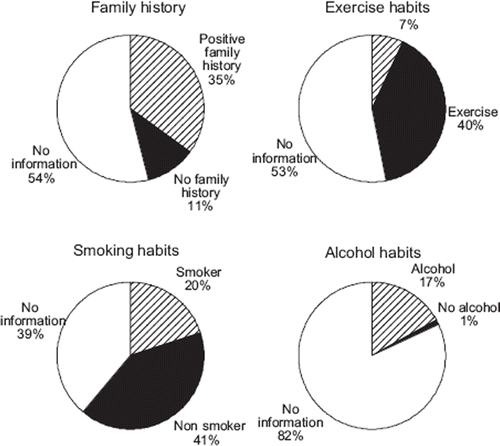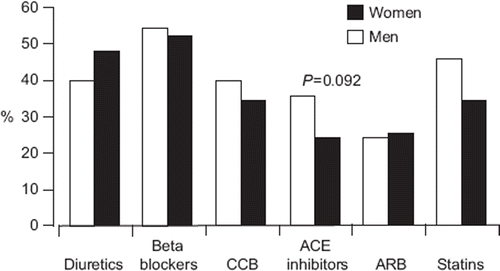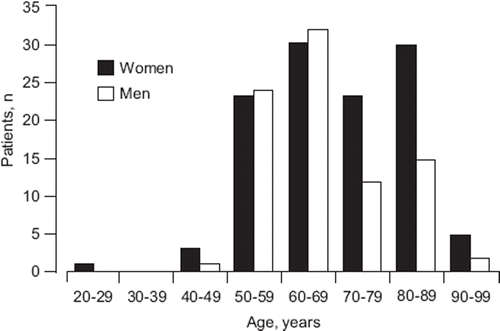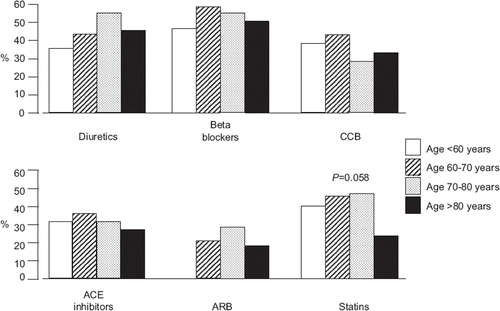Abstract
The awareness and control of cardiovascular risk factors other than blood pressure in hypertensive subjects in primary healthcare is not well described. This was examined by data extraction from electronic records from a random sample (115 women and 85 men) corresponding to two-thirds of all hypertensive subjects within a well-defined geographic area in Sweden. Target blood pressure (<140/90 mmHg, <130/80 mmHg if diabetes or kidney disease) was achieved in 27%, and lipid levels (total and LDL-cholesterol <5 and <3.0 mmol/l, respectively) in 42%. Beta-blockers were the most common antihypertensive drug class; 39% were given lipid lowering drugs. The distributions of antihypertensive and lipid lowering drugs were similar across gender and age groups. Patient records often contained information on body mass index, lipid levels, diabetes, left ventricular hypertrophy, microalbuminuria, and smoking habits (reported in 89%, 89%, 73%, 67%, 62% and 61%), but rarely on physical exercise, family history, concurrent cardiovascular disease or alcohol habits (reported in 47%, 46%, 39% and 18%). In conclusion, hypertensive patients in primary healthcare do not have well controlled blood pressure and lipids. The awareness and documentation of several cardiovascular risk factors is low. Improvement in risk assessment and treatment may have substantial effects on prognosis.
Introduction
Cardiovascular disease is the major cause of premature death in Europe, and high blood pressure is the leading cause for mortality in both the developing and the developed world (Citation1). However, cardiovascular risk factors other than hypertension, including hyperlipidemia, smoking, diabetes mellitus, overweight and physical inactivity, are also important contributors to an increased cardiovascular risk. The evidence in favor of treating hypertension and other cardiovascular risk factors is strong (Citation2–5). Thus, treatment of hypertensive patients is well justified for the individual subject, for the healthcare provider, and from a societal prospective.
Hypertension is common, with an estimated prevalence at 27% in the adult Swedish population (Citation6) and similar rates in other countries (Citation7,Citation8). A majority of hypertensive patients do not reach target blood pressure (Citation7–9). The awareness and control of other established cardiovascular risk factors in hypertensive subjects in the primary care setting is, however, not well described. Such information may be of major importance as it is a prerequisite for the correct use of risk equation scores in order to make risk assessment in the individual patient. Proper identification of high-risk patients may have substantial impact on cardiovascular prognosis.
Thus, the aim of present study was to examine how well hypertensive patients in primary care were treated to target with regard to blood pressure and other established cardiovascular risk factors. Second, we examined how various cardiovascular risk factors were identified and documented, as this is a prerequisite for intervention and evaluation. We carefully examined medical records from two-thirds of all hypertensive patients within a well-defined geographic area of one primary healthcare centre with a high socio-economic status and well trained board-certified primary healthcare physicians.
Patients and methods
At the time of the investigation, approximately 5800 subjects lived in the catchment area of Stocksund primary healthcare centre in north-eastern greater Stockholm, Sweden, where four board certified specialists in family medicine worked. There were 300 patients with a diagnosis hypertension registered at the primary healthcare centre during January 1, 2002 to March 31, 2003. Of these, 200 patients were arbitrarily chosen from the computerized medical record system. Medical records for these 200 patients were carefully checked from January 1, 1993 to June 30, 2004, and data were extracted from the text, laboratory records and recordings of electrocardiograms. Current drug treatments for hypertension and for lipid disorders were registered. The latest available information was always noted.
The standard procedure for blood pressure recording was to use the right arm after 5–15 min of rest in a seated position, by use of an automatic blood pressure device (Omron M4, Omron Europe BV, Hoofddorp, The Netherlands) with an appropriately sized cuff. Target blood pressure was considered to be <140/90 mmHg, in patients with diabetes mellitus or kidney disease <130/80 mmHg.
Diabetes mellitus was defined as a fasting blood glucose >6.5 mmol/l and/or ongoing antidiabetic therapy with diet and/or drugs. Fasting serum levels of total cholesterol, low-density lipoprotein (LDL)-cholesterol and triglycerides were noted, as well as serum creatinine levels, HbA1c and the presence of microalbuminuria (Clinitek Status, Siemens Medical Solutions Diagnostics, Tererytown, NY, USA; an albumin/creatinine ratio >3.4 mg/mmol in a morning spot sample was considered positive). Target level for total cholesterol was <5.0 mmol/l, LDL-cholesterol <3.0 mmol/l, triglycerides <2.0 mmol/l, and HbA1c <6.5%. All analyses were performed by standard procedures.
Body size was expressed as body mass index, where <25 kg/m2 was considered normal, 25–30 kg/m2 overweight and >30 kg/m2 obese. Medical records did generally not contain information on waist circumference.
We extracted recorded data on current or previous cardiovascular disease (transitory ischemic attacks, stroke, angina pectoris and myocardial infarction, congestive heart failure, peripheral vascular disease, atrial fibrillation, presence of left ventricular hypertrophy by electrocardiogram or echocardiography), smoking, alcohol consumption, physical activity, and family history of cardiovascular disease. Physical activity was classified as (Citation1) not at all, (Citation2) walking on a regular basis, (Citation3) regular exercise more than three times weekly. Family history of cardiovascular disease was classified as (Citation1) present in first grade of relatives of any age, (Citation2) present in first grades male relatives <55 years of age and in female relatives <65 of age, (Citation3) present in second grade relatives, or (Citation4) no known relevant disease among relatives.
Data are presented as mean values±SD. Statistical evaluation was preformed by Student’s t-test, analysis of variance and the χ2 test, as appropriate A probability (p) <0.05 was considered significant.
The Ethics Committee of the Karolinska Hospital approved of this project as a quality assurance project in healthcare, and no further permission was necessary.
Results
General
Demographic information of the study population is provided in . The age distribution of the 115 women and 85 men is shown in .
Table I. Background characteristic.
Blood pressure levels, lipid levels and the related drug treatments were almost always documented in medical records, whereas the presence or not of diabetes mellitus, microalbuminuria, and signs of left ventricular hypertrophy was reported in 72%, 62% and 67%, respectively (). There were 154 patients with total cholesterol 5.0 mmol/l or higher or ongoing lipid lowering drug therapy (i.e. statins). Other risk factors and markers, reflecting family history and life style were less often reported ().
Figure 2. The written documentation of risk factors and markers, reflecting family history and life style, in patient records of the 200 patients with hypertension.

The proportion of diabetes mellitus appeared similar in women and men, but men tended to have microalbuminuria more often (p=0.059; ). Microalbuminuria was examined in 39 and present in seven of the patients (17%) reported to have diabetes mellitus, and in a similar proportion of patients (7/59; 12%) not having diabetes. Smoking was equally common among female and male patients ().
Drug treatment
Most patients received one or two antihypertensive drugs. Thus, eight patients received no drug, 70 one drug, 70 two drugs, 41 three drugs, and 11 received four or more drugs. Beta-blockers were most common (53%), followed by diuretics (45%), calcium antagonists (37%), angiotensin-converting enzyme inhibitors (29%), angiotensin receptor blockers (25%) and other drugs (2%); 4% had no treatment. The distribution of antihypertensive drug classes was similar in women and men, although angiotensin-converting enzyme inhibitors tended to be less common in women (p=0.092; ). The antihypertensive drug classes were prescribed similarly across all age groups ().
Figure 3. Drug classes prescribed, according to gender in the study of 200 patients. CCB, calcium-channel blocker; ACE, angiotensin-converting enzyme; ARB, angiotensin receptor blocker. There were no significant differences between the groups.

Between one third and one half of the patients were given lipid lowering drugs (i.e. statins), similarly in women and men (). Lipid lowering drugs appeared less common among the oldest (p=0.058; ). Statins were more common with increasing number of antihypertensive drugs prescribed (p<0.001). Thus, among those with one antihypertensive drug 27% were given statins, with two antihypertensive drugs 39%, with three drugs 56%, and patients with four or more drugs 73% were given lipid lowering drugs.
Patients treated to target
Considerably fewer patients reached systolic than diastolic target blood pressures (i.e. <140/90 mmHg, in patients with diabetes mellitus or kidney disease <130/80 mmHg; ). Few diabetic patients reached both systolic and diastolic target blood pressure, approximately 15%, whereas patients with no documented diabetes archived target blood pressure in approximately 28%. There were no differences between women and men. If target blood pressure was set to <140/90 mmHg irrespective of concurrent diabetes mellitus or kidney disease, 38% reached systolic target (35% female and 42% male), 71% reached diastolic target (74% female and 66% male), and 33% reached systolic and diastolic target combined (33% female and 34% male). Systolic and diastolic target blood pressure was reached in two and three of the seven diabetic patients, respectively, with microalbuminuria.
Table II. Proportion of patients achieving targets.
Target blood pressure was obtained to a similar degree in all age groups. Thus, a blood pressure <140/90 mmHg (<130/80 mmHg in patients with diabetes mellitus or kidney disease) was achieved in 27%, 30%, 28% and 23% of patients aged <60, 61–70, 71–80 and >80 years. The corresponding numbers if blood pressure was set to <140/90 mmHg irrespective of concurrent diabetes mellitus or kidney disease were 33%, 34%, 36% and 31%.
The proportion of patients reaching target blood pressure was not related to the number of antihypertensive drugs given, i.e. patients on one, two, three, and four or more drugs achieved target blood pressure in 30%, 31%, 22% and 28%.
Around half of all patients reached target total cholesterol and LDL-cholesterol levels (). However, a considerably higher proportion of the diabetic patients were treated to target levels. Male patients were more often treated to target cholesterol levels (total cholesterol, p=0.001; LDL-cholesterol, p=0.098; both total and LDL-cholesterol, p=0.009). Triglyceride levels, however, tended to be better controlled in female than in male patients (p=0.058; ). Approximately four in five diabetic patients had a HbA1c value within target ().
Documentation of risk factors and previous or current cardiovascular disease
The proportion of patients where risk factors or markers reflecting family history and life style are presented in . No alcohol use was reported by two patients, 16 consumed less than one glass of wine daily, 10 consumed one to two glasses daily, and eight patients more than two glasses of wine daily. Body mass index () was <25 kg/m2 in 34 patients, 25–30 in 43, 31–35 in 18 and >35 in two patients. A majority of those with information about physical activity were regularly active. Thus, 52 patients went walking regularly, and 28 performed more intensive physical activity regularly; 14 patients did no regular exercise. An early-onset cardiovascular event was present in 12 out of the 69 patients with a positive family history of cardiovascular disease (i.e. first-degree relative).
Patient records contained information about previous or current cardiovascular disease in only 78 (39%) patients. Thus, there were seven patients with an acute myocardial infarction, five with coronary artery bypass grafting or percutaneous coronary intervention, 25 with angina pectoris, nine with congestive heart failure, nine with atrial fibrillation, three with an aortic aneurysm, six with intermittent claudication, two with a peripheral arterial thromboembolism, three with a retinal artery thrombosis, 26 with stroke or transient ischemic attack, and six with renal failure; three medical records contained information that there was no cardiovascular disease.
Discussion
This study included a random sample of two-thirds of all patients diagnosed with hypertension in primary healthcare within a well-defined geographic area, regardless of socio-economic status, and with no bias in the selection in patients or physicians related to any voluntary participation. All data including information on prescribed drugs were extracted from electronic records, not self-reported questionnaires. We found that almost all patients attending the primary healthcare centre with a diagnosis of hypertension received antihypertensive drug treatment. However, only approximately one in four subjects achieved target blood pressure (<140/90 mmHg; <130/80 mmHg in patients with diabetes or kidney disease). Our results confirm recent findings in Sweden (Citation9–11) and elsewhere (Citation8,Citation12,Citation13). Thus, there is room for improvement in antihypertensive control in primary healthcare. This may have a substantial impact to reduce cardiovascular risk (Citation14).
The available evidence suggests that hypertension should be treated in a similar way in women and in men (Citation15). Accordingly, we found that blood pressure control was similar across gender. Furthermore, age did not seem to affect blood pressure control. Beta-blockers were the most commonly prescribed antihypertensive drug class, most likely reflecting previous Swedish recommendations. The distribution of drug classes was similar in women and men, and all drug classes were prescribed similarly across all age groups. Of note, the proportions reaching target blood pressure was similar in patients on only one or two antihypertensive drugs (i.e. 30% and 31%) as in those on three or more drugs (i.e. 22% and 28%). This may suggest that addition of another drug class is not frequently used in patients with uncontrolled blood pressure. Indeed, current guidelines strongly suggest that the vast majority of hypertensive patients can only achieve target blood pressure control by a combination of two or more antihypertensive drugs (Citation2,Citation3).
We show that lipid levels are most often recorded in hypertensive patients, and lipid abnormalities are common, as 77% had total cholesterol of 5.0 mmol/l or more, or ongoing lipid lowering drug therapy, similarly to findings by others (Citation10,Citation11). Approximately one third achieved target lipid levels, around one half of the patients if only total cholesterol and LDL-cholesterol were considered. Of note, patients with concomitant diabetes were more often treated to lipid target levels, reflecting adherence to recommendations to prescribe satins to all diabetic patients (Citation4,Citation5). Lipid lowering therapy was prescribed to a similar extent in women and men. However, lipid lowering drugs were more common with increasing number of antihypertensive drugs, suggesting that these patients had more advanced hypertensive disease. This use of lipid lowering drugs appears to be in agreement with the shown beneficial effects on cardiovascular events and the cost effectiveness of statin treatment in hypertensive patients with an increased risk (Citation16,Citation17). However, this and other studies (Citation10,Citation11) show that lipid lowering therapy in hypertensive patients in primary healthcare can be improved and be used in many more patients.
One major finding is that medical records were often lacking information on well-established cardiovascular risk factors, such as concurrent cardiovascular disease (e.g. previous cardiovascular event or diabetes, or signs of hypertensive target organ damage) and risk factors and markers reflecting life style and family history (). This information is generally not difficult to obtain by a structured history taken from the patient, a standard physical examination and routine laboratory tests. Lacking such information, however, makes it difficult to perform a correct risk assessment in the individual patient, and reduces the chances to influence modifiable risk factors. Without this documentation, it is also more difficult to follow up of risk modifications. The use of risk equation scores, standard operation procedures for patient visits in primary healthcare for hypertensive subjects, and the use of systematic quality assurance programs may be of value to improve patient care in this setting, as reviewed elsewhere (Citation18,Citation19), as also shown for diabetes (Citation20). However, our results suggest that the primary care physicians were unable to apply standard risk equation scores to many patients in their daily practice.
In conclusion, this study confirms observations that blood pressure and lipids are not well controlled in hypertensive patients in primary healthcare. In addition, we find that the awareness and documentation of many cardiovascular risk factors is low, although such information is generally easy to obtain. There is room for improvement of risk factor awareness, documentation, and treatment of hypertensive patients. This may have substantial impact on cardiovascular prognosis.
Acknowledgements
Supported by Karolinska Institutet, Stockholm, Sweden, and Stockholm County Council.
Declaration of interest: The authors report no conflicts of interest. The authors alone are responsible for the content and writing of the paper.
References
- Ezzati M, Lopez AD, Rodgers A, Vander Hoorn S, Murray CJ. Comparative Risk Assessment Collaborating Group. Selected major risk factors and global and regional burden of disease. Lancet. 2002;360:1347–1360.
- Mancia G, De Backer G, Dominiczak A, Cifkova R, Fagard R, Germano G, . 2007 Guidelines for the Management of Arterial Hypertension: The Task Force for the Management of Arterial Hypertension of the European Society of Hypertension (ESH) and of the European Society of Cardiology (ESC). J Hypertens. 2007;25:1105–1187.
- Mancia G, Laurent S, Agabiti-Rosei E, Ambrosioni E, Burnier M, Caulfield MJ, . Reappraisal of European guidelines of hypertension management: A European Society of Hypertension Task Force document. J Hypertens. 2009;27:2121–2159.
- Graham I, Atar D, Borch-Johnsen K, Boysen G, Burell G, Cifkova R, . European guidelines on cardiovascular disease prevention in clinical practice: Full text. Fourth Joint Task Force of the European Society of Cardiology and other societies on cardiovascular disease prevention in clinical practice (constituted by representatives of nine societies and by invited experts). Eur J Cardiovasc Prev Rehabil. 2007;14 Suppl 2:S1–S113.
- American Diabetes Association. Standards of medical care in diabetes–2009. Diabetes Care. 2009;32 Suppl 1:13–61.
- Lindholm, LH, Agenäs I, Carlbeg B, Dahlgren H, de Faire U, Hedblad B, . Moderately elevated blood pressure. A systematic literature review. Stockholm: The Swedish Council on Technology Assessment in Health Care. 2004. Report 170/1, 1–248 and 170/2, 1–514.
- Wolf-Maier K, Cooper RS, Banegas JR, Giampaoli S, Hense HW, Joffres M, . Hypertension prevalence and blood pressure levels in 6 European countries, Canada, and the United States. JAMA. 2003;289:2363–2369.
- Cutler JA, Sorlie PD, Wolz M, Thom T, Fields LE, Roccella EJ. Trends in hypertension prevalence, awareness, treatment, and control rates in United States adults between 1988–1994 and 1999–2004. Hypertension. 2008;52:818–827.
- Weinehall L, Ohgren B, Persson M, Stegmayr B, Boman K, Hallmans G, . High remaining risk in poorly treated hypertension: The ‘rule of halves’ still exists. J Hypertens. 2002;20:2081–2088.
- Hedblad B, Nerbrand C, Ekesbo R, Johansson L, Midlöv P, Brunkstedt I, . High blood pressure despite treatment: Results from a cross-sectional primary healthcare-based study in southern Sweden. Scand J Prim Health Care. 2006; 24:224–230.
- Journath G, Hellénius ML, Petersson U, Theobald H, Nilsson PM; Hyper-Q Study Group Sweden. Sex differences in risk factor control of treated hypertensives: A national primary healthcare-based study in Sweden. Eur J Cardiovasc Prev Rehabil. 2008;15:258–262.
- Fagard RH, van den Enden M, Leeman M, Warling X. Survey on treatment of hypertension and implementation of World Health Organization/International Society of Hypertension risk stratification in primary care in Belgium. J Hypertens. 2002;20:1297–1302.
- Buckley B, Shanahan E, Colwell N, Turgonyi E, Bramlage P, Perry IJ. Blood pressure control in hypertensive patients in Irish primary care practices. J Clin Hypertens (Greenwich). 2009;11:432–440.
- Law MR, Morris, JK, Wald NJ. Use of blood pressure lowering drugs in the prevention of cardiovascular disease: Meta-analysis of 147 randomised trials in the context of expectations from prospective epidemiological studies. BMJ. 2009;338:1245–1252.
- Ljungman C, Mortensen L, Kahan T, Manhem K. Treatment of mild to moderate hypertension by gender perspective. J Womens Health. 2009;18:1049–1062.
- Sever PS, Dahlöf B, Poulter NR, Wedel H, Beevers G, Caulfield M, . Prevention of coronary and stroke events with atorvastatin in hypertensive patients who have average or lower-than-average cholesterol concentrations, in the Anglo-Scandinavian Cardiac Outcomes Trial-Lipid Lowering Arm (ASCOT-LLA): A multicentre randomised controlled trial. Lancet. 2003;361:1149–1158.
- Lindgren P, Buxton M, Kahan T, Poulter NR, Dahlöf B, Sever PS, . Cost-effectiveness of atorvastatin for the prevention of coronary and stroke events: An economic analysis of the Anglo-Scandinavian Cardiac Outcomes Trial-lipid-lowering arm (ASCOT-LLA). Eur J Cardiovasc Prev Rehabil. 2005;12:29–36.
- Fahey T, Schroeder K, Ebrahim S. Educational and organisational interventions used to improve the management of hypertension in primary care: A systematic review. Br J Gen Pract. 2005;55:875–882.
- Walsh JM, McDonald KM, Shojania KG, Sundaram V, Nayak S, Lewis R, . Quality improvement strategies for hypertension management: A systematic review. Med Care. 2006;44:646–657.
- Eliasson B, Cederholm J, Nilsson P, Gudbjörnsdóttir S. The gap between guidelines and reality: Type 2 diabetes in a National Diabetes Register 1996–2003. Diabet Med.2005;22: 1420–1426.

